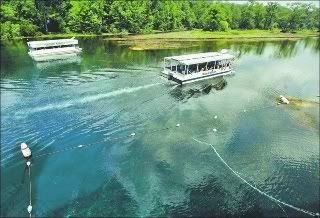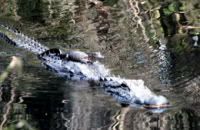Once again, Florida springs protection fails in session
By Bruce Ritchie
Tallahassee Democrat
May 12, 2008
To some springs supporters, it seemed a modest proposal.
Legislation sponsored by Sen. Burt Saunders, R-Naples, called for a pilot project in Marion County to establish protection zones for Silver and Rainbow Springs. Creating the zones would lead to reductions in nitrogen from farms, sewage treatment plants and septic tanks.
The same thing has been pitched for Central Florida's Wekiva Springs and for Wakulla Springs. But efforts to begin a statewide springs-protection strategy have failed in the Legislature in recent years. And it happened again in the 2008 session.
With home builders saying that new septic tank requirements could increase the cost of homes, Saunders said sponsors of other springs bills only wanted studies. The Florida Department of Environmental Protection supported the Saunders bill.
Florida's springs are "something that attract people to Florida, that attract our tourists here," Saunders said. "The home builders may be killing the goose that laid the golden egg if they don't spend some extra effort protecting it."
A spokeswoman for the Florida Home Builders Association said her group raised concerns about the bill during a workshop early in the session but she also said her group didn't work to kill the proposal.
Some of Florida's springs have become choked with weeds and algae. Nitrogen from septic tanks, sewage treatment plants, fertilizer and livestock operations are feeding the plant growth, scientists say.
Saunders, chairman of the Senate Committee on Environmental Preservation and Conservation and term-limited out of office this year, said he introduced the bill at the request of Marion County officials. Silver and Rainbow springs in Marion County have had increasing nitrogen levels in recent years, said Jerry Brooks, director of DEP's Division of Environmental Assessment and Restoration.
The senator's bill would have required "protection zones" around Silver and Rainbow springs. The bill effectively would have required advanced sewage treatment plants or nitrogen-reducing "performance-based" septic systems.
In Tallahassee, the city has agreed to spend $160 million to provide advanced treatment at its sewage plants to protect Wakulla Springs. Wakulla County last year began requiring performance-based septic tanks and Leon County this year is considering a similar requirement near the springs.
But some home builders and developers say the advanced septic systems are too expensive or are unproven. The Florida Home Builders Association says the systems can cost $15,000 more than standard systems.
"Our concern was it would become an unnecessary financial burden on homeowners," said Edie Ousley, association spokeswoman.
The Florida Department of Health estimates the cost of performance-based septic systems at $3,000 to $5,000 more than a standard system.
Saunders' bill also would have required DEP to establish pollution limits at the Marion County springs. DEP has proposed pollution limits at Wakulla and Wekiva Springs in Central Florida.
But he said the possible House sponsor of the bill, Rep. Debbie Boyd, D-Newberry, only wanted to do a study of springs statewide -- a study that Saunders said had already been done. Boyd said this week that Marion County officials told her during the session they were concerned about the Saunders bill.
Saunders said he let his bill die in a Senate committee, while Boyd's bill to study the springs died in the House.
"There was no sense in doing another study," Saunders said.

A tour boats cruises the surface of Wakulla Springs.
MORE INFO
Support Friends of Wakulla Springs State Park.
Click here and here to learn more about springs via the Florida Department of Environmental Protection.
Recommend reading: Florida Springs blog.

Wildwood Preservation Society is a non-profit 501(c)(4) project of the Advocacy Consortium for the Common Good. Click here to learn more.
"it's all connected"













No comments:
Post a Comment